None of us enjoy having a headache, yet many people suffer from them on a daily basis. Headaches are a common, painful condition affecting almost 50% of the global population. They often can be debilitating, make us stay home from work and make us irritable. All too often, treatment consists of over-the-counter pain medicine, prescription pain medicine or even invasive injections, surgery….What if your headache was actually produced in your neck and could be treated without medicine or invasive medical procedures?
Head pain that is referred from the bony structures or soft-tissue of the neck is commonly called a “cervicogenic headache”. During certain neck movements, sustained postures, or traumatic injury, stretching or compression forces are placed on the joints, muscles, ligaments and nerves of the upper neck. This may cause damage to these structures if the forces are beyond what the tissues can withstand. The nerves that supply the upper neck also supply the skin overlying the head, forehead, jaw line, back of the eyes and ears. As a result, pain arising from structures of the upper neck may refer pain to any portion of the head or face. Patients suffering from cervicogenic headaches will often have 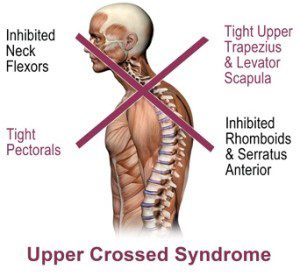 faulty neck posture or restricted cervical range of motion.
faulty neck posture or restricted cervical range of motion.
The head pain can be triggered or reproduced by active neck movement, passive neck positioning or by applying pressure to the involved joints or soft-tissues of the upper neck. Muscular trigger points are usually found in the suboccipital, cervical and shoulder musculature and these trigger points can also refer pain to the head when manually stimulated.
Cervicogenic headache symptoms include:
- Pain in the back or front of your head , pain on one side of your head or pain behind your eyes.
- Pain which begins from your neck and extends to between your shoulder blades or upper shoulders.
- Pain which is exacerbated or changed by certain neck movements or neck positions.
- Pain which is triggered by pressure applied to the upper part of the neck near the base of the skull (known as the suboccipital region) or in the upper trapezius area.
- Neck stiffness.
- Blurred vision.
- Nausea, vomiting, and/or dizziness.
Contributing factors to the development of Cervicogenic headache:
- Poor posture
- Neck and upper back stiffness
- Muscle imbalance (selective weakness and selective tightness of certain neck and upper back muscle groups)
- Previous neck trauma (whiplash)
- Inappropriate work station set-up
- Inappropriate pillow or sleeping posture
- Sedentary lifestyle
- Stress
Treatment for Cervicogenic Headaches: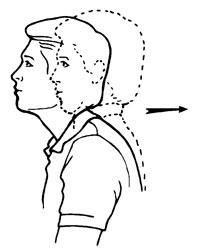
- Exercise: A primary treatment modality and prevention technique is exercise. Exercise in general has been shown to be beneficial in treating and preventing cervical pain and headaches. Selective stretching of tight structures combined with strengthening of the weaker, over-stretched soft-tissues will reduce the mechanical stress placed on the upper neck and thus, reduce the amount of pain being referred to the head.
- Focus on
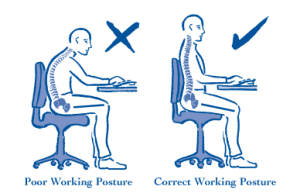 your posture: Poor posture is a bane of modern society. The most common example of poor posture is a forward head with rounded shoulders. This causes excessive muscular tension throughout the cervical spine, upper trapezius region and mid-thoracic area. In addition, this also leads to muscle weakness and/or dysfunction in the cervical spine and upper thoracic area. Poor posture is almost always associated with muscle knots and trigger points. Emphasis should also be placed on workplace ergonomics.
your posture: Poor posture is a bane of modern society. The most common example of poor posture is a forward head with rounded shoulders. This causes excessive muscular tension throughout the cervical spine, upper trapezius region and mid-thoracic area. In addition, this also leads to muscle weakness and/or dysfunction in the cervical spine and upper thoracic area. Poor posture is almost always associated with muscle knots and trigger points. Emphasis should also be placed on workplace ergonomics.
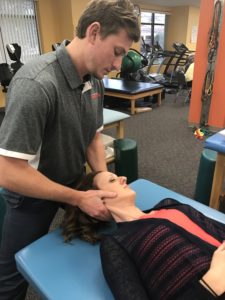
- Manual Therapy: A skilled physical therapist will use individualized manual therapy techniques, such as joint mobilization/manipulation, soft-tissue work and myofascial release to restore proper joint and soft-tissue function, eliminate trigger points and improve the overall quality of upper cervical movement.
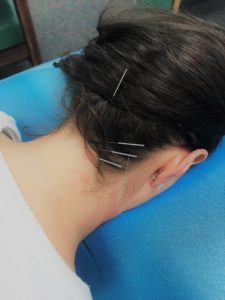
- Dry Needling: Technique where sterile needles are inserted into tight bands within an overactive muscle. The very fine monofilament needles are inserted into the skin and muscle targeting specific trigger points or “knots” which have been shown to be headache triggers.
Cervicogenic headaches can be effectively treated through skilled physical therapy. Due to the fact that Cervicogenic headaches can often times mimic symptoms associated with migraine headaches or even cluster headaches, it would be a good idea to visit your physical therapist for a proper evaluation. The skilled physical therapists at the Center for Physical Therapy and Sports Medicine are all highly trained in the evaluation and treatment of headaches and cervical conditions. If you suffer from headaches, please call or come by one of our two offices today to schedule an evaluation. You should not have to suffer another day in your life!
To learn more about the author of this blog, click here: Dr. Rich Linkonis

